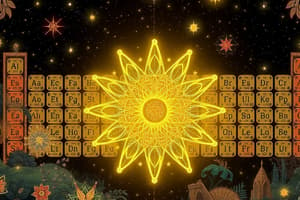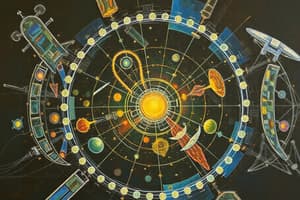Podcast
Questions and Answers
What significant particle did Rutherford discover?
What significant particle did Rutherford discover?
- Neutron
- Electron
- Alpha particle
- Proton (correct)
Which scientist is credited with the discovery of the neutron?
Which scientist is credited with the discovery of the neutron?
- Thomson
- Bohr
- Chadwick (correct)
- Millikan
What was demonstrated by the cathode ray tube experiments related to atomic structure?
What was demonstrated by the cathode ray tube experiments related to atomic structure?
- Existence of neutrons
- Existence of protons
- Existence of electrons (correct)
- Existence of quarks
What problem was noted regarding certain atomic models?
What problem was noted regarding certain atomic models?
Which of the following correctly describes the charge and mass relationship of electrons?
Which of the following correctly describes the charge and mass relationship of electrons?
Which type of intermolecular force is responsible for the attraction between HCl molecules?
Which type of intermolecular force is responsible for the attraction between HCl molecules?
What type of intermolecular force would be present in nonpolar molecules such as $O_2$?
What type of intermolecular force would be present in nonpolar molecules such as $O_2$?
Which of the following molecules is likely to have the highest boiling point?
Which of the following molecules is likely to have the highest boiling point?
What physical state would $Br_2$ be in at standard conditions?
What physical state would $Br_2$ be in at standard conditions?
Which of the following statements about intermolecular forces is correct?
Which of the following statements about intermolecular forces is correct?
What is primarily noted alongside each element in the handwritten periodic table?
What is primarily noted alongside each element in the handwritten periodic table?
In the context of the periodic table mentioned, what characteristic is not usually included in standard periodic tables?
In the context of the periodic table mentioned, what characteristic is not usually included in standard periodic tables?
What aspect of the periodic table is specifically noted to have characteristics discussed?
What aspect of the periodic table is specifically noted to have characteristics discussed?
What is the atomic number (Z) of nitrogen?
What is the atomic number (Z) of nitrogen?
How is the overall structure of the handwritten periodic table described?
How is the overall structure of the handwritten periodic table described?
What elements of the periodic table are indicated in the rows and columns aside from symbols?
What elements of the periodic table are indicated in the rows and columns aside from symbols?
Which isotope of nitrogen has a mass number of 14?
Which isotope of nitrogen has a mass number of 14?
What is the mass of nitrogen-14 in kilograms?
What is the mass of nitrogen-14 in kilograms?
Which chemical formula represents potassium oxide?
Which chemical formula represents potassium oxide?
How many isotopes of nitrogen are mentioned?
How many isotopes of nitrogen are mentioned?
What is a significant limitation of the Bohr model of the atom?
What is a significant limitation of the Bohr model of the atom?
Which of the following correctly represents a covalent bond?
Which of the following correctly represents a covalent bond?
Which statement is true regarding metallic bonds?
Which statement is true regarding metallic bonds?
How are Lewis structures helpful in chemistry?
How are Lewis structures helpful in chemistry?
Which of the following substances is classified as polar due to its molecular structure?
Which of the following substances is classified as polar due to its molecular structure?
What does the Lewis structure of HCN primarily illustrate?
What does the Lewis structure of HCN primarily illustrate?
Which group in the periodic table is known for containing the Alkali Metals?
Which group in the periodic table is known for containing the Alkali Metals?
Which bonding type is characterized by a strong covalent network structure?
Which bonding type is characterized by a strong covalent network structure?
What is the primary behavior of metals in terms of electron configuration?
What is the primary behavior of metals in terms of electron configuration?
What does the term 'sea of electrons' refer to in metallic bonding?
What does the term 'sea of electrons' refer to in metallic bonding?
Which group in the periodic table contains the Chalcogens?
Which group in the periodic table contains the Chalcogens?
How is the ionic bond formed in K₂O?
How is the ionic bond formed in K₂O?
What is a key difference between diamond and graphite?
What is a key difference between diamond and graphite?
Flashcards
Periodic Table
Periodic Table
A chart that organizes elements by their atomic number, electron configuration, and recurring chemical properties.
Atomic Number
Atomic Number
The small number above an element's symbol, indicating the number of protons in the atom's nucleus.
Group (or Family)
Group (or Family)
A column on the periodic table that groups elements with similar chemical properties.
Period
Period
Signup and view all the flashcards
Non-metals
Non-metals
Signup and view all the flashcards
Thomson's Discovery
Thomson's Discovery
Signup and view all the flashcards
Rutherford's Experiment
Rutherford's Experiment
Signup and view all the flashcards
Chadwick's Discovery
Chadwick's Discovery
Signup and view all the flashcards
Millikan's Oil Drop
Millikan's Oil Drop
Signup and view all the flashcards
Atomic Models
Atomic Models
Signup and view all the flashcards
Atomic number (Z)
Atomic number (Z)
Signup and view all the flashcards
Isotopes
Isotopes
Signup and view all the flashcards
Mass number (A)
Mass number (A)
Signup and view all the flashcards
Chemical Formula
Chemical Formula
Signup and view all the flashcards
Potassium oxide (K₂O)
Potassium oxide (K₂O)
Signup and view all the flashcards
What is the Bohr model of the atom?
What is the Bohr model of the atom?
Signup and view all the flashcards
What are Lewis structures?
What are Lewis structures?
Signup and view all the flashcards
What are ionic bonds?
What are ionic bonds?
Signup and view all the flashcards
What are covalent bonds?
What are covalent bonds?
Signup and view all the flashcards
What are metallic bonds?
What are metallic bonds?
Signup and view all the flashcards
Intermolecular Forces
Intermolecular Forces
Signup and view all the flashcards
London Dispersion Forces
London Dispersion Forces
Signup and view all the flashcards
Dipole-Dipole Forces
Dipole-Dipole Forces
Signup and view all the flashcards
Melting Point ($T_f$) and Boiling Point ($T_b$)
Melting Point ($T_f$) and Boiling Point ($T_b$)
Signup and view all the flashcards
State of Matter and Intermolecular Forces
State of Matter and Intermolecular Forces
Signup and view all the flashcards
Lewis Structure
Lewis Structure
Signup and view all the flashcards
Covalent Bonding
Covalent Bonding
Signup and view all the flashcards
Ionic Bonding
Ionic Bonding
Signup and view all the flashcards
Metallic Bonding
Metallic Bonding
Signup and view all the flashcards
Ion Lattice
Ion Lattice
Signup and view all the flashcards
Alkali Metals
Alkali Metals
Signup and view all the flashcards
Alkaline Earth Metals
Alkaline Earth Metals
Signup and view all the flashcards
Halogens
Halogens
Signup and view all the flashcards
Study Notes
Periodic Table
- The periodic table organizes chemical elements
- Elements are arranged by atomic number and recurring chemical properties
- Elements are grouped into periods (rows) and groups (columns)
- Elements in the same group have similar chemical properties
- The table is used to predict the properties of elements
- Elements are represented by a chemical symbol, atomic number, and atomic mass.
Atomic Structure
- Atoms are composed of protons, neutrons, and electrons
- Protons and neutrons are located in the nucleus of an atom
- Electrons orbit the nucleus in specific energy levels
- The number of protons in an atom's nucleus determines its atomic number
- The number of protons and neutrons determine its mass number.
- Atomic mass is approximately equal to the number of protons and neutrons.
Studying That Suits You
Use AI to generate personalized quizzes and flashcards to suit your learning preferences.




